英国文学课件 新古典主义——浪漫主义
- 格式:doc
- 大小:289.50 KB
- 文档页数:22
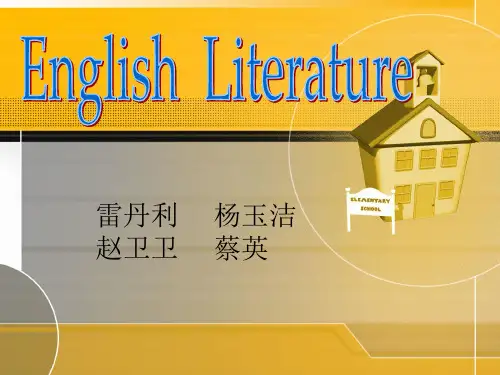

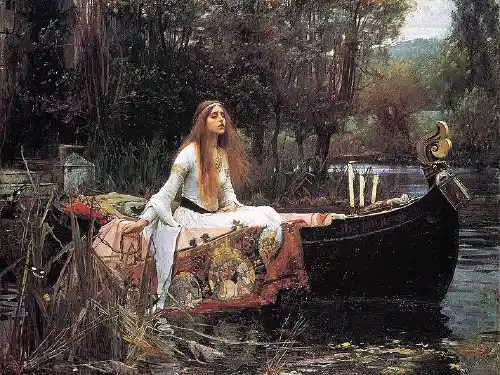
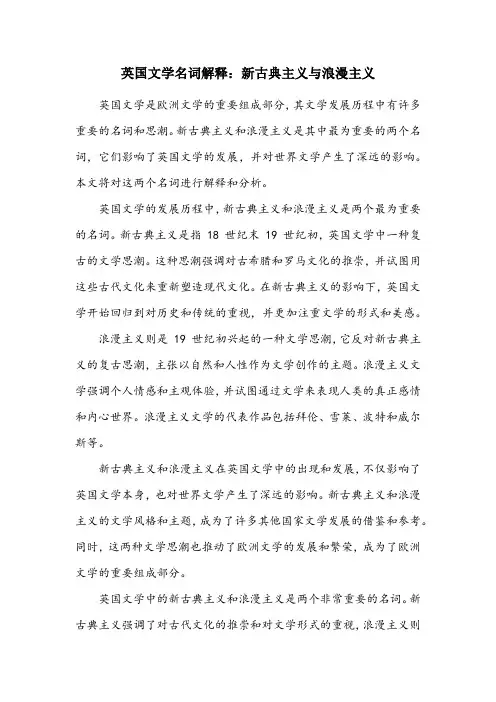
英国文学名词解释:新古典主义与浪漫主义英国文学是欧洲文学的重要组成部分,其文学发展历程中有许多重要的名词和思潮。
新古典主义和浪漫主义是其中最为重要的两个名词,它们影响了英国文学的发展,并对世界文学产生了深远的影响。
本文将对这两个名词进行解释和分析。
英国文学的发展历程中,新古典主义和浪漫主义是两个最为重要的名词。
新古典主义是指 18 世纪末 19 世纪初,英国文学中一种复古的文学思潮。
这种思潮强调对古希腊和罗马文化的推崇,并试图用这些古代文化来重新塑造现代文化。
在新古典主义的影响下,英国文学开始回归到对历史和传统的重视,并更加注重文学的形式和美感。
浪漫主义则是 19 世纪初兴起的一种文学思潮,它反对新古典主义的复古思潮,主张以自然和人性作为文学创作的主题。
浪漫主义文学强调个人情感和主观体验,并试图通过文学来表现人类的真正感情和内心世界。
浪漫主义文学的代表作品包括拜伦、雪莱、波特和威尔斯等。
新古典主义和浪漫主义在英国文学中的出现和发展,不仅影响了英国文学本身,也对世界文学产生了深远的影响。
新古典主义和浪漫主义的文学风格和主题,成为了许多其他国家文学发展的借鉴和参考。
同时,这两种文学思潮也推动了欧洲文学的发展和繁荣,成为了欧洲文学的重要组成部分。
英国文学中的新古典主义和浪漫主义是两个非常重要的名词。
新古典主义强调了对古代文化的推崇和对文学形式的重视,浪漫主义则
强调个人情感和主观体验,并通过文学来表现人类的真正感情和内心世界。
这两种文学思潮不仅影响了英国文学本身,也对世界文学产生了深远的影响。

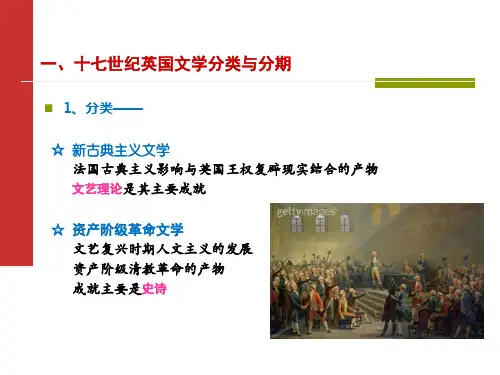

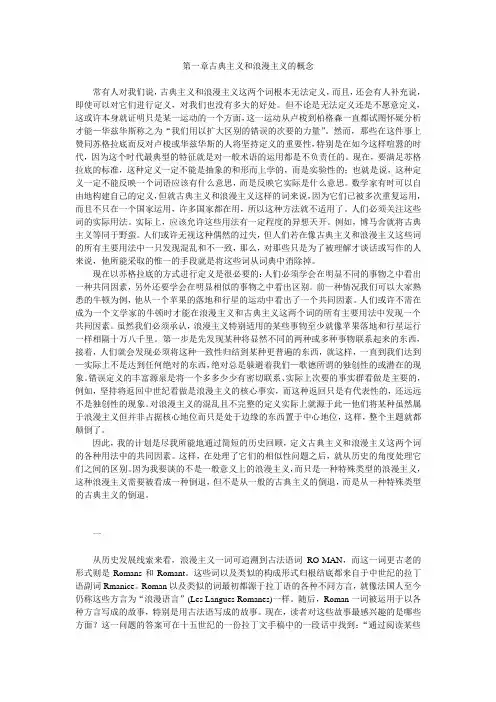
第一章古典主义和浪漫主义的概念常有人对我们说,古典主义和浪漫主义这两个词根本无法定义,而且,还会有人补充说,即使可以对它们进行定义,对我们也没有多大的好处。
但不论是无法定义还是不愿意定义,这或许本身就证明只是某一运动的一个方面,这一运动从卢梭到柏格森一直都试图怀疑分析才能—华兹华斯称之为“我们用以扩大区别的错误的次要的力量”。
然而,那些在这件事上赞同苏格拉底而反对卢梭或华兹华斯的人将坚持定义的重要性,特别是在如今这样喧嚣的时代,因为这个时代最典型的特征就是对一般术语的运用都是不负责任的。
现在,要满足苏格拉底的标准,这种定义一定不能是抽象的和形而上学的,而是实验性的;也就是说,这种定义一定不能反映一个词语应该有什么意思,而是反映它实际是什么意思。
数学家有时可以自由地构建自己的定义,但就古典主义和浪漫主义这样的词来说,因为它们已被多次重复运用,而且不只在一个国家运用,许多国家都在用,所以这种方法就不适用了。
人们必须关注这些词的实际用法。
实际上,应该允许这些用法有一定程度的异想天开。
例如,博马舍就将古典主义等同于野蛮。
人们或许无视这种偶然的过失,但人们若在像古典主义和浪漫主义这些词的所有主要用法中一只发现混乱和不一致,那么,对那些只是为了被理解才谈话或写作的人来说,他所能采取的惟一的手段就是将这些词从词典中消除掉。
现在以苏格拉底的方式进行定义是很必要的:人们必须学会在明显不同的事物之中看出一种共同因素,另外还要学会在明显相似的事物之中看出区别。
前一种情况我们可以大家熟悉的牛顿为例,他从一个苹果的落地和行星的运动中看出了一个共同因素。
人们或许不需在成为一个文学家的牛顿时才能在浪漫主义和古典主义这两个词的所有主要用法中发现一个共同因素。
虽然我们必须承认,浪漫主义特别适用的某些事物至少就像苹果落地和行星运行一样相隔十万八千里。
第一步是先发现某种将显然不同的两种或多种事物联系起来的东西,接着,人们就会发现必须将这种一致性归结到某种更普遍的东西,就这样,一直到我们达到—实际上不是达到任何绝对的东西,绝对总是躲避着我们—歌德所谓的独创性的或潜在的现象。

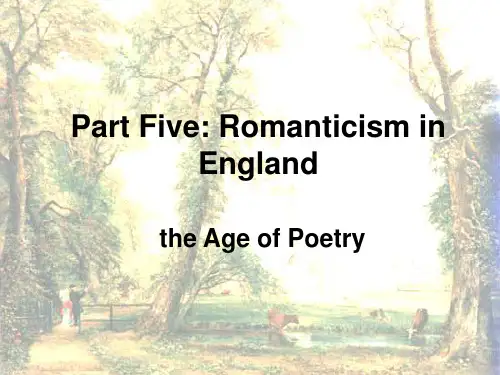
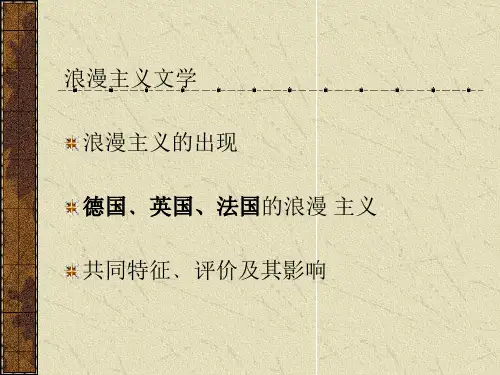
英国⽂学课件新古典主义——浪漫主义Chapter 12 John MiltonParadise Lost(completed in 1667. In 1674, he published the final version of the epic. 12 books)Type of Work:Paradise Lost is an epic poem which —like the epic poems of Homer, Dante, Vergil, and Goethe—tells a story about momentous events while incorporating grand themes that are timeless and universal. Sources:Milton used the Bible, Homer's Iliad and Odyssey, Vergil's Aeneid, and the stories in Greco-Roman mythology as sources of information and as writing models. The Bible's Book of Genesis is the main source for his retelling of the story of creation and the first humans, Adam and Eve.Settings:The settings are heaven, hell, the firmament (苍穹) (Chaos), and earth.Characters:God the Father, God the Son: (trinity)Two of the three divine persons making up the all-powerful Godhead, the single deity(神性)that created and ruled all that exists outside of itself. The third divine person, the Holy Spirit, does not play a role in Paradise Lost. God the Father is portrayed as just but merciful, condemning (批判) the defiant (⽬中⽆⼈)and unrepentant (不后悔的) rebel angels but permitting redemption of the repentant Adam and Eve. God the Son volunteers to redeem them by becoming human and enduring suffering and death.Satan (Lucifer, Archfiend): Powerful and prideful angel who, with legions (众多的) of supporters, leads an unsuccessful rebellion against God and suffers eternal damnation. T o gain revenge, he devises a plan to corrupt God's newly created beings, Adam and Eve, through deceit. Modern readers often admire him for his steely defiance (藐视). He would rather rule in hell, he says, than serve in heaven. It was not Milton's intent, however, to create an admirable character; rather his intent was to create a character of colossal (巨⼤的) hatred — loathsome (令⼈讨厌的), execrable (恶劣的), incurably remorseless (冷酷⽆情的).Adam and Eve: The first human beings, created by God to fill the void(真空)that resulted when God cast Satan and his supporters out of the celestial realm. Adam and Eve live on the planet earth in utter happiness in a special garden where spring is the only season and love and godly living prevail. Though they have all that they want and need, cunning Satan tells them they can have knowledge and status beyond their reach if only they eat of the fruit of the Tree of Knowledge. Eve can become a goddess, he says. Vanity overtakes her. She eats. Adam reluctantly does the same.Gabriel, Raphael, Michael, Uriel: Powerful and fearless angels on the side of God.Beelzebub, Mammon, Belial, Moloch: Powerful leaders in Satan's army. In a great council in hell, each of them speaks his mind on what policy devil-kind should follow after losing paradise. Should they make a new war? Should they make peace?Ithuriel, Zephron: Angels who expel Satan from the Garden of Eden with the help of a sign from God. Satan returns to the garden later to complete his devious enterprise.Mulciber: Fallen angel who designs hell's capital city and seat of government, Pandemonium. In ancient Roman mythology, Mulciber is another name for Vulcan (Greek: Hephaestus), god of fire and the forge. As a blacksmith, he kept shop in burning mountains (volcanoes).Sin: Daughter of Satan. She was born from his head in the manner of Athena, Greek goddess of wisdom and war, who sprang from the forehead of Zeus, king of the gods.天动说的design rather than the Copernican design (哥⽩尼式设计). The former placed earth at the center of the solar system, with the sun and other celestial bodies orbiting it. Copernicus and other scientists later proved that the earth orbits the sun. Milton was aware of the Copernican theory, but he used the Ptolemaic design—either because he believed it was the more credible theory or because he believed it would better serve his literary purpose. In Paradise Lost, Adam inquires about the movements of celestial bodies—in particular, whether earth orbits the sun or vice versa—in his conversation with the archangel天使Raphael, but Raphael gives no definite answer. Raphael may have been speaking for Milton.Style and Verse FormatMilton wrote Paradise Lost in dignified, lofty, melodic English free of any colloquialisms and slangs that would have limited the work's timeliness and universality. The format, Milton says in an introductory note, is "English heroic verse without rhyme"—in other words, blank verse, the same verse form used by Shakespeare in his plays. Milton's strong religious faith infuses the poem with sincerity and moral purpose, but he does not allow his enthusiasm for his subject to overtake control of his writing. Though Milton frequently uses obscure allusions to mythology and history, as well as occasional difficult wordsand phrases, his language is never deliberately affected or ostentatious炫耀的. What is more, it does not preach and does not take the reader on circumlocutory迂回的expeditions. Like a symphony composer—mighty Beethoven, for example —Milton is always in control, tempering his creative genius with his technical discipline.With a good dictionary and an annotated有注解的text, a first-time reader of Milton can easily follow and understand the story while developing an appreciation for the exquisite writing.Epic ConventionsIn Paradise Lost, Milton used the classical epic conventions—literary practices, rules, or devices established by Homer that became commonplace in epic poetry. Some of these practices were also used in other genres ofliterature. Among the classical conventions Milton used are the following:(1) The invocation 祈祷of the muse, in which a writer requests divine help in composing his work.(2) Telling a story with which readers or listeners are already familiar; they know the characters, the plot, and the outcome. Most of the great writers of the ancient world—as well as many great writers in later times, including Shakespeare—frequently told stories already known to the public. Thus, in such stories, there were no unexpected plot twists, no surprise endings. If this sounds strange to you, the modern reader and theatergoer, consider that many of the most popular motion pictures today are about stories already known to the public.(3) Beginning the story in the middle, a literary convention known by its Latin term in media res资源(in the middle of things). Such a convention allows a writer to begin his story at an exciting part, then flash back to fill the reader in on details leading up to that exciting part.(4) Announcing or introducing a list of characters who play a major role in the story. They may speak at some length about how to resolve a problem (as the followers of Satan do early in Paradise Lost).(5) Conflict in the celestial realm. Divine beings fight and scheme against one another in the epics of Homer and Vergil, and they do so in Paradise Lost on a grand scale, with Satan and his forces opposing God and his forces. (6) Use of dramatic irony. Dramatic irony is a literary device in which a character in a story fails to see or understand what is obvious to the audience or readers. Dramatic irony appears frequently in the plays of the ancient Greeks. ImageryMilton's imagery is at times graceful and elegant, as in this memorable personification in Book 6 [Waked by the circling hours, with rosy hand Unbarred the gates of light. (lines 2-4)]At other times, the imagery is imposing and awe-inspiring, as in this description in Book 7In Book 8, Milton describes the commission of the first sin in simple, straightforward language, followed by a succinct personification summing up the terrible effects of the iniquityMilton also uses personification in Book 4 in this beautiful passage about a quiet night, the starry sky, and the ascendancy of the moonEnjambment跨⾏连续Milton uses frequently uses enjambment (also spelled enjambement) in the poem. It is a literary device in which a poet does not complete his sentence or phrase at the end of one line but allows it to carry over to the next line. Milton's use of enjambment helps the poem flow from one line to the next.Of man's first disobedience, and the fruitBrought death into the world. . .(Book 1, lines 1-3)Of that forbidden tree, whose mortal tasteMain ThemeIn Book 1 of Paradise Lost, Milton reveals the central theme of the work: to justify the ways of God to man. Justify here means to explain and defend, and ultimately to vindicate澄清, God’s course of action in dealing with Adam and Eve after they succumbed to the temptation of Satan and ate forbidden fruit.Other ThemesInordinate 过度的pride: It leads to Satan's downfall and his continuing defiance of God.Envy: Arising from Satan's pride, it makes him jealous of God the Son, who is the favorite of God the Father. Revenge: It motivates Satan to corrupt Adam and Eve and thereby subvert God's plans.Vanity: It leads Eve to believe—under the temptation of Satan—that she can become godlike.Deceit: Satan appears in many disguises and tells many lies during his mission to trick Adam and Eve.Infidelity: Adam betrays God by siding with Eve and eating the forbidden fruit.Unbridled 不受约束的pursuit of knowledge: It leads Adam and Eve to seek knowledge beyond their ken, knowledge that will make them godlike.Volition意志: Angels and humans alike possess free will, enabling them to make decisions. Satan freely chooses to rebel against God, and Adam and Eve freely choose to eat forbidden fruit. The consequences of their actions are their own fault, not God's. Milton uses this theme to help support the central theme, "to justify the ways of God to man."Disobedience违抗: All sins are acts of disobedience against God, impairing or cutting off the sinner's relationship with God. Adam and Eve and all of the devils disobey God through their sins.Loyalty: Loyalty to God and his ways are necessary for eternal salvation. Loyalty requires obedience. All of the good angels exhibit loyalty.Repentance悔悟: Even though Adam and Eve have disobeyed God, their repentance makes them eligible for eventual salvation.Hope: At the end of Paradise Lost, Adam and Eve enter the imperfect world with hope; they can yet attain eternal salvation. Redemption赎回: Through the suffering and death of the Son of God, sinful man can reconcile himself with God if he is sincerely sorry for his sins.ClimaxThe climax, or turning point, of Paradise Lost occurs when Adam and Eve succumb to Satan's temptations and eat the forbidden fruit. This act of disobedience results in their downfall and eviction from Paradise.What Is an Angel?An angel is a supernatural being that serves God by praising and adoring Him and by carrying out special missions that assist humans. Angels have the additional task of opposing and punishing devils. Devils are angelscast out of heaven because they rebelled against God. The word angel derives from the Greek word angelos, meaning messenger. The major western religions—Christianity, Judaism, and Islam—all accept the existence of angels. The rank of angels from highest to lowest is as follows:1. Seraphim (Seraph)2. Cherubim (Cherub)3. Thrones4. Dominations5. Virtues6. Powers7. Principalities8. Archangels9. AngelsChapter 13 The Seventeenth-Century Prose2007-11-12 13:53I. Bible1. The Bible is the name given to the revelation of God to man contained in sixty-six books or pamphlets, bound together and forming one book.2. The Books of the Bible:Old Testament(39 Books, written in the Hebrew language between 1400 and 400B.C. )About the creation of the world, the origin of the Jewish people, its history, religion, law, and poetry. New Testament(27 Books, written in the Greek language between 40 and 100 A.D.)About Jesus Christ’s life, his deeds and teachingsSon of an important official / Studied law, became a barrister and entered House of Commons, legal advisor to Elizabeth I / Attorney General and Lord Chancellor under James I; forced out of office in 1621 / Retired to his estate to write and study / Tried to convince Elizabeth I and James I to embrace natural philosophy as statecraft2. Major WorksEssays (1594)The Advancement of Learning (1605) Great Instauration and Novum Organum (1620) New Atlantis (posthumous)3. Important Baconian ideas●Reliance on the evidence of the senses and instruments●Progress through technology●Technological transformation of nature to make it useful to humanity●State Institutions of science: institutes, centralization, technocratic expertise4. Bacon’s Essays●Essay as a form of literature, the essay is a composition of moderate length, usually in prose, which deals in aneasy, cursory way with the external conditions of a subject, and, in strictness, with that subject, only as it affects the writer. The essay was invented by Montaigne.●Bacon’s essaysBacon offers his views on a whole smorgasbord of topics ranging from Truth, Death,' Adversitie', Marriage & the single life, Love, Boldness, Superstition, Friendship, Health, Ambition, Youth, Beauty to Anger & Fame.Features of Bacon’s essays●Bacon’s essays are the first example of that genre in English lit erature and have been recognized as animportant landmark in the development of English prose. The essays are famous for the pithy aphoristic style, which he had defended in principle in The Advancement of Learning as proper for the expression of tentative opinions.●There is an obvious stylistic change in the Essays. The sentences in the first edition are charged and crowdedwith symmetries. They are composed in a rather affected way. However, the final edition not only enlarges the range of theme, but also brings forth the looser and more persuasive style.●The essays are well arranged and enriched by Biblical allusions, metaphors and cadences. In general, Bacon’s literary style is noted for three prominent qualities: directness, terseness, and forcefulness.II. John Bunyan (1628-1688)1. Life and CareerHad very little schooling, but abnormally active imagination with dreams and fears of devils and hell-fire / Worked in the tinker's trade / Served in the parliamentary army / Married in 1649 / Joined a non-sectarian church / Was arrested and imprisoned for making illegal preaching in the surrounding villages / Wrote Pilgrim’s Progress in Prison2. Points of View●Religiously, a devout Christian, and a firm non-conformist of the Anglican Church, he believed that man’s final salvation could be achieved only by one’s own spiritual struggle.●Politically, with a deep hatred for the corrupted, hypocritical rich, he condemned oppression, falsehood,indulgence in pleasure seeking and many other vices of the money-corrupted upper class, but eulogized the truth-seeking Christian.3. The Pilgrim's Progress(1) Story : A tale of adventure on a perilous path, encountering giants, wild beasts, hobgoblins, etc. The tale based on human experience: e.g. the moving account of his death with Hopeful(2) Major charactersChristian Faithful Hopeful Giant Despair Ignorance Christiana(3) Major theme:●Spiritual salvation for mankind●The cost of salvation●The road to salvation is difficult and lonely ●Salvation is attainable by all who seek it. ●To grow in holiness is a daily battle, in which therewill be setbacks and encouragements, but which isa battle worth fighting(4) The basic metaphor: Life is a journey.●"Everyone sojourning in the flesh is passing through this earth to a mysterious state of future bliss .... thePilgrim's progress is toward no earthly destination.―●The journey is from this world to the next world.●Pilgrim, one who strives to obtain salvation of their soul through a physical journey in which love for God, and notlove for material things, drives them.●Pilgrimage: the journey to a distant sacred goal; it is found in all the great religions of the world. It is a journeyboth outwards to hallowed places and inwards to spiritual improvement; it can express penance for past evils, or the search for future good; the pilgrim may pursue spiritual ecstasy in the sacred sites of a particular faith, or seek a miracle through the medium of God or a saint.●Johnson praised John Bunyan highly. "His Pilgrim's Progress has great merit, both for invention, imagination,and the conduct of the story; and it has had the best evidence of its merit, the general and continued approbation of mankind. Few books, I believe, have had a more extensive sale. It is remarkable, that it begins very much like the poem of Dante; yet there was no translation of Dante when Bunyan wrote. There is reason to think that he had read Spenser."(5) Special features●The most successful religious allegory in English language●Vivid characterization: Travelers who represent states of the soul, or moral attitudes●Style: Modeled on the prose style of the English Bible; Simple diction; colloquial expressions; andstraightforward sentence structuresIII. John Dryden (1631-1700)1. Life and CareerBorn in a country g entry’s family / Received his education at Cambridge / Shifted to the royalist side after Restoration / Became a prominent poet, dramatist, and critic in his time2. Major WorksAbsalom and AchitophelAntony and Cleopatra: All for LoveAn Essay of Dramatic Poesy3. Influence on Literature●Dryden is the ―lock by which the waters of English poetry were let down from the mountains of Shakespeare andMilton to the plain of Pope.‖●His satire exerted a fruitful influence on the most brilliant verse satirists of the next century.●As a prose writer, Dryden had a very marked influence on English literature in shortening his sentences, andespecially in writing naturally, without depending on literary ornamentation to give effect to what he is saying.Primarily focusing on drama, the poetry of plays, he creates a dialogue between poet/critics of He chooses to review the existing, generally accepted conventions and decide in what respects they are being followed, or whether they should be followed by English writers.Chapter 14 Introduction to the 18th centuryI. Introductory Remarks:The period (1660-1798) began with the Restoration of Charles II, during whose reign the leading literary figure was John Dryden, with whom the neoclassical literature came into being, and concluded with the death of Samuel Johnson in 1784, the last important advocate of neoclassicism. By Johnson’s death, neoclassicism came to a decline the 18th century. Complacency (self-satisfaction) marked the beginning of the 18th century. The upper classes, in complete control now, wanted no religious enthusiasts and revolutionaries. They believed in reason. This rational approach to social and literary problems have given it the title of ―The Age of Reason‖, while the desire for perfect form which resulted in adaptations of Greek and Latin models has caused it to be called ―The Neoclassic Age.‖1. The Glorious Revolution (1688)1) James II (reactionary rule and ruthless suppression of the Protestant rebellion) / discontent from the bourgeoisie and the aristocracy / Mary and her husband, William were invited to be joint sovereigns of the English throne / James II was forced to abdicate and fled to France in 1688. / This was called the Glorious or Bloodless Revolution in England2) After that England gradually became a constitutional monarchy, and power passed from the king to the parliament and the cabinet.2. Religious ConflictsWith the triumph of the Glorious Revolution, the conflicts were very intense between the Anglican Church and its two adversaries – Protestant Dissenters and Roman Catholics. Finally England was firmly established as a dominantly Protestant nation. In the late 17th century, Deism⾃然神教admitted their belief in a Supreme Being or the God as the creator of the world, but they glorified reason and so rejected the so-called “revealed”religious truth.(reason underlying the so-called “revealed”religious truth)3. The Rapid Expanding of the British Empirethe defeat of the Holland navy; a series of victories over France / the Act of Union of 1707 – Great Britain / from Canada in the west to India in the east / Swift, Burke, Sheridan and Goldsmith (from Ireland); Thomson, Boswell, Hume and Burns (from Scotland).4. The Industrial Revolutionthe discovery of the Laws of Gravitation by Newton; steam engine (James Watt); te xtile machines… / the Enclosure 5. Two-Party Politics (The Tory and the Whig)the Tory (conservative) defended the kingship, the old traditions and the noble country families / the Whig (liberal) sought toincrease the powers of the Parliament and to advance commerce and education.6. Connection between Politics and Literaturepolitical pamphlets / literary men were eager to offer their services in shaping the government7. The American War of Independence and the French Revolution (1789-1794)The century closed, however, with revolutions, exploding in the American colonies and in France. Though these outbursts of revolutionar y movements did not change England’s position as a big industrial and capitalist power, they had the most far-reaching influences upon men’s thoughts and were left most deeply in literature, esp in the literature of the Age of Romanticism which followed.III. Enlightenment启蒙运动and its effects on English literature1. It was a progressive intellectual movement throughout Western Europe in the 18th and Russia in the 19th centuries. The movement was, on the whole, an expression of the struggle of the bourgeoisie against feudalism. The enlighteners fought against class inequality, stagnation停滞, prejudices and other feudal survivals.2. The enlightenment was so called because it considered the chief means for the betterment of the society was the―enlightenment‖ or ―education‖ of the people. In other words they believed in the power of reason and their watchword was ―common sense‖. That is why the 18th century in England has often been called ―the Age of Reason‖. Most of the enlightenment thinkers believed that social problems could not be solved by church doctrines or by the power of God but should be solved with human intelligence.3. Most of the important writers of the 18th century belonged to the enlightenment. In their works these writers criticized different aspects of contemporary England, discussed social problems and the management of the government, and some even partly defended the interests of the exploited laboring masses, the peasants, and the working people in the cities. The literature of the Enlightenment in England mainly appealed to the middle class readers.IV. Neo-Classicism1. Neoclassicism was a reaction against the intricacy 复杂and occasional obscurity晦涩, boldness and the extravagance of European literature of the late Renaissance, and in favor of simplicity, clarity, restraint, regularity and good sense. In England, neoclassicism was initiated by Dryden, culminated in Pope and continued by Johnson.2. The writers were considered neoclassic because they modeled themselves on classical Greek or Latin authors in order to achieve perfect form in literature. The general tendency of neoclassical literature was to look at social and political life critically, to emphasize intellect rather than imagination, the form rather than the content of a sentence.3. Chief characteristics of Neoclassic literature1) The neoclassic writers manifested a strong traditionalism, which was clearly shown in their immense respect for classical writers.2) The neoclassic believed that literature was primarily an ―art‖, which must be perfected by long study and practice. They laid much emphasis on the correct, the appropriate, on restraint and discipline, paid much attention to their style, and respected the established rules of their art.3) The neoclassic regarded poetry as imitation of human life –a mirror up to nature. Emphasis was placed on what human beings possess in common (共性)–representative characteristics, and widely shared experiences, thoughts, feelings and tastes.4) The neoclassic believed that the poet is the maker – the maker of the representative images of human actions and of the world, and the purpose for which he makes this image of life is to teach. In order to teach effectively, he must please the reader by his fictions, and by all the ornaments of language, metrics and rhetoric that belong to his craft. This concept of the nature of the poet inevitably determines the didactic, satirical, artificial and orderly qualities of neoclassicism.5) The neoclassic deduced 演绎rules from the practice of early masters and invented new rules of their own.In drama, they adhered to the three unities of time, place and action, regularity in construction, and the presentation of types rather than individuals.In di ction, they highly regarded ―witty‖ expressions. They preferred the use of artificial and stock diction. ?In poetry, they demanded it to follow the ancient divisions: lyric, epic, didactic, satiric or dramatic, and each class should be guided by its own principles.In versification诗律, the age was famous for its ―closed heroic couplet‖, that is, two rhyming lines of iambic pentameter which contains within itself a complete statement and so is closed by a semicolon, period, question mark, or exclamation point.The neoclassic poetry differs from that of the Elizabethan Age in three ways. First, it is more formal, with its demand to follow exact rules, while the Elizabethans wrote in a more natural style sometimes without regard to rules; second, it is more artificial, polished, prosaic单调的, and dull and lacks the creative vigor of the Elizabethans; third, the chief poetic form of neoclassicism is heroic couplet which replaced the variety of forms in the Elizabethan Age.4. The literature of the Neoclassic Age (1660-1784)1) the first, extending to the death of Dryden in 1700, may be thought of as the period in which English ―neoclassical‖literature came into being and its critical principles were formulated; the second, ending with the death of Pope in 1744 and of Swift in 1745, brought to its culmination the literary movement; the third, concluding with the death of Johnson in 1784 and the publication of William Cowper’s The Task in 1785, was a period in which neoclassical principles gradually petered out 耗尽and were replaced by the Romantic Movement.Chapter 15 The 18th Century PoetryI. Alexander Pope (1688-1744)1. Life StoryBorn in London of a successful merchant’s family, of Roman Catholic faith / weak and crippled from childhood / did not have regular schooling but was taught at home by a priest / his only amusement was reading and writing. He taught himself by reading and translating Latin, French, Italian, and Greek poets, with the help of dictionaries and grammar books. Pope began to write poems when he was only 12.2. His Poems1) the first groupdidactic and philosophical poems, including Essay on Criticism (1711); Moral Essays (1731); An Essay on Man (1734);2) The second group contains his poems of social satires, such as the Rape of the Lock (1714); An Heroic-Comical Poem and The Dunciad3) The third group is composed of his translations of Homer’s Iliad and Odyssey.3. His Influences1) He had a brilliant wit, a sharp critical sense, and a deadly pen. He brought the neoclassicism in England to its climax.2) In his hands, the heroic couplet achieved all the finish, elegance, wit and pointedness which the form invited.3) As a technician in English verse 韵⽂he has never been excelled, and he occupied such a prominent place in the literary world of his time that not infrequently the literary epoch of early 18th century has been named after him as “The Age of Pope”. After his time, esp since the 19th century, Pope has been much criticized and some critics have called him a versifier and not a poet, meaning that he wrote clever and standardized but very mechanical sort of verse which had not flights of poetic imagination. Bla ke summarized him as ―elegant formalism‖. Byron, however, thought highly of him, defended him, and was much under his influence. Nowadays he is rated by some critics as second only to Shakespeare and Milton, and the equal of Wordsworth.II. Thomas Gray (1716-1771)The most scholarly and well-balanced of all the early romantic poets and the most outstanding of the minor poets of the mid-18th century.1. Life StoryBorn in London / educated first at Eton and then at Cambridge / spend 2 years on a grand tour of the European Continent / after graduation he continued to live at Cambridge and was appointed professor at Cambridge.2. His WorksOn Spring;。
Chapter 12 John MiltonParadise Lost(completed in 1667. In 1674, he published the final version of the epic. 12 books)Type of Work:Paradise Lost is an epic poem which —like the epic poems of Homer, Dante, Vergil, and Goethe—tells a story about momentous events while incorporating grand themes that are timeless and universal. Sources:Milton used the Bible, Homer's Iliad and Odyssey, Vergil's Aeneid, and the stories in Greco-Roman mythology as sources of information and as writing models. The Bible's Book of Genesis is the main source for his retelling of the story of creation and the first humans, Adam and Eve.Settings:The settings are heaven, hell, the firmament (苍穹) (Chaos), and earth.Characters:• God the Father, God the Son: (trinity)Two of the three divine persons making up the all-powerful Godhead, the single deity(神性)that created and ruled all that exists outside of itself. The third divine person, the Holy Spirit, does not play a role in Paradise Lost. God the Father is portrayed as just but merciful, condemning (批判) the defiant (目中无人)and unrepentant (不后悔的) rebel angels but permitting redemption of the repentant Adam and Eve. God the Son volunteers to redeem them by becoming human and enduring suffering and death.• Satan (Lucifer, Archfiend): Powerful and prideful angel who, with legions (众多的) of supporters, leads an unsuccessful rebellion against God and suffers eternal damnation. T o gain revenge, he devises a plan to corrupt God's newly created beings, Adam and Eve, through deceit. Modern readers often admire him for his steely defiance (藐视). He would rather rule in hell, he says, than serve in heaven. It was not Milton's intent, however, to create an admirable character; rather his intent was to create a character of colossal (巨大的) hatred — loathsome (令人讨厌的), execrable (恶劣的), incurably remorseless (冷酷无情的).• Adam and Eve: The first human beings, created by God to fill the void(真空)that resulted when God cast Satan and his supporters out of the celestial realm. Adam and Eve live on the planet earth in utter happiness in a special garden where spring is the only season and love and godly living prevail. Though they have all that they want and need, cunning Satan tells them they can have knowledge and status beyond their reach if only they eat of the fruit of the Tree of Knowledge. Eve can become a goddess, he says. Vanity overtakes her. She eats. Adam reluctantly does the same.• Gabriel, Raphael, Michael, Uriel: Powerful and fearless angels on the side of God.• Beelzebub, Mammon, Belial, Moloch: Powerful leaders in Satan's army. In a great council in hell, each of them speaks his mind on what policy devil-kind should follow after losing paradise. Should they make a new war? Should they make peace?• Ithuriel, Zephron: Angels who expel Satan from the Garden of Eden with the help of a sign from God. Satan returns to the garden later to complete his devious enterprise.• Mulciber: Fallen angel who designs hell's capital city and seat of government, Pandemonium. In ancient Roman mythology, Mulciber is another name for Vulcan (Greek: Hephaestus), god of fire and the forge. As a blacksmith, he kept shop in burning mountains (volcanoes).• Sin: Daughter of Satan. She was born from his head in the manner of Athena, Greek goddess of wisdom and war, who sprang from the forehead of Zeus, king of the gods.天动说的design rather than the Copernican design (哥白尼式设计). The former placed earth at the center of the solar system, with the sun and other celestial bodies orbiting it. Copernicus and other scientists later proved that the earth orbits the sun. Milton was aware of the Copernican theory, but he used the Ptolemaic design—either because he believed it was the more credible theory or because he believed it would better serve his literary purpose. In Paradise Lost, Adam inquires about the movements of celestial bodies—in particular, whether earth orbits the sun or vice versa—in his conversation with the archangel天使Raphael, but Raphael gives no definite answer. Raphael may have been speaking for Milton.Style and Verse FormatMilton wrote Paradise Lost in dignified, lofty, melodic English free of any colloquialisms and slangs that would have limited the work's timeliness and universality. The format, Milton says in an introductory note, is "English heroic verse without rhyme"—in other words, blank verse, the same verse form used by Shakespeare in his plays. Milton's strong religious faith infuses the poem with sincerity and moral purpose, but he does not allow his enthusiasm for his subject to overtake control of his writing. Though Milton frequently uses obscure allusions to mythology and history, as well as occasional difficult words and phrases, his language is never deliberately affected or ostentatious炫耀的. What is more, it does not preach and does not take the reader on circumlocutory迂回的expeditions. Like a symphony composer—mighty Beethoven, for example —Milton is always in control, tempering his creative genius with his technical discipline.With a good dictionary and an annotated有注解的text, a first-time reader of Milton can easily follow and understand the story while developing an appreciation for the exquisite writing.Epic ConventionsIn Paradise Lost, Milton used the classical epic conventions—literary practices, rules, or devices established by Homer that became commonplace in epic poetry. Some of these practices were also used in other genres ofliterature. Among the classical conventions Milton used are the following:(1) The invocation 祈祷of the muse, in which a writer requests divine help in composing his work.(2) Telling a story with which readers or listeners are already familiar; they know the characters, the plot, and the outcome. Most of the great writers of the ancient world—as well as many great writers in later times, including Shakespeare—frequently told stories already known to the public. Thus, in such stories, there were no unexpected plot twists, no surprise endings. If this sounds strange to you, the modern reader and theatergoer, consider that many of the most popular motion pictures today are about stories already known to the public.(3) Beginning the story in the middle, a literary convention known by its Latin term in media res资源(in the middle of things). Such a convention allows a writer to begin his story at an exciting part, then flash back to fill the reader in on details leading up to that exciting part.(4) Announcing or introducing a list of characters who play a major role in the story. They may speak at some length about how to resolve a problem (as the followers of Satan do early in Paradise Lost).(5) Conflict in the celestial realm. Divine beings fight and scheme against one another in the epics of Homer and Vergil, and they do so in Paradise Lost on a grand scale, with Satan and his forces opposing God and his forces. (6) Use of dramatic irony. Dramatic irony is a literary device in which a character in a story fails to see or understand what is obvious to the audience or readers. Dramatic irony appears frequently in the plays of the ancient Greeks. Imagery•Milton's imagery is at times graceful and elegant, as in this memorable personification in Book 6 [Waked by the circling hours, with rosy hand Unbarred the gates of light. (lines 2-4)]•At other times, the imagery is imposing and awe-inspiring, as in this description in Book 7•In Book 8, Milton describes the commission of the first sin in simple, straightforward language, followed by a succinct personification summing up the terrible effects of the iniquity•Milton also uses personification in Book 4 in this beautiful passage about a quiet night, the starry sky, and the ascendancy of the moonEnjambment跨行连续Milton uses frequently uses enjambment (also spelled enjambement) in the poem. It is a literary device in which a poet does not complete his sentence or phrase at the end of one line but allows it to carry over to the next line. Milton's use of enjambment helps the poem flow from one line to the next.Of man's first disobedience, and the fruitBrought death into the world. . .(Book 1, lines 1-3)Of that forbidden tree, whose mortal tasteMain ThemeIn Book 1 of Paradise Lost, Milton reveals the central theme of the work: to justify the ways of God to man. Justify here means to explain and defend, and ultimately to vindicate澄清, God’s course of action in dealing with Adam and Eve after they succumbed to the temptation of Satan and ate forbidden fruit.Other ThemesInordinate 过度的pride: It leads to Satan's downfall and his continuing defiance of God.Envy: Arising from Satan's pride, it makes him jealous of God the Son, who is the favorite of God the Father. Revenge: It motivates Satan to corrupt Adam and Eve and thereby subvert God's plans.Vanity: It leads Eve to believe—under the temptation of Satan—that she can become godlike.Deceit: Satan appears in many disguises and tells many lies during his mission to trick Adam and Eve.Infidelity: Adam betrays God by siding with Eve and eating the forbidden fruit.Unbridled 不受约束的pursuit of knowledge: It leads Adam and Eve to seek knowledge beyond their ken, knowledge that will make them godlike.Volition意志: Angels and humans alike possess free will, enabling them to make decisions. Satan freely chooses to rebel against God, and Adam and Eve freely choose to eat forbidden fruit. The consequences of their actions are their own fault, not God's. Milton uses this theme to help support the central theme, "to justify the ways of God to man."Disobedience违抗: All sins are acts of disobedience against God, impairing or cutting off the sinner's relationship with God. Adam and Eve and all of the devils disobey God through their sins.Loyalty: Loyalty to God and his ways are necessary for eternal salvation. Loyalty requires obedience. All of the good angels exhibit loyalty.Repentance悔悟: Even though Adam and Eve have disobeyed God, their repentance makes them eligible for eventual salvation.Hope: At the end of Paradise Lost, Adam and Eve enter the imperfect world with hope; they can yet attain eternal salvation.Redemption赎回: Through the suffering and death of the Son of God, sinful man can reconcile himself with God if he is sincerely sorry for his sins.ClimaxThe climax, or turning point, of Paradise Lost occurs when Adam and Eve succumb to Satan's temptations and eat the forbidden fruit. This act of disobedience results in their downfall and eviction from Paradise.What Is an Angel?An angel is a supernatural being that serves God by praising and adoring Him and by carrying out special missions that assist humans. Angels have the additional task of opposing and punishing devils. Devils are angelscast out of heaven because they rebelled against God. The word angel derives from the Greek word angelos, meaning messenger. The major western religions—Christianity, Judaism, and Islam—all accept the existence of angels. The rank of angels from highest to lowest is as follows:1. Seraphim (Seraph)2. Cherubim (Cherub)3. Thrones4. Dominations5. Virtues6. Powers7. Principalities8. Archangels9. AngelsChapter 13 The Seventeenth-Century Prose2007-11-12 13:53I. Bible1. The Bible is the name given to the revelation of God to man contained in sixty-six books or pamphlets, bound together and forming one book.2. The Books of the Bible:Old Testament(39 Books, written in the Hebrew language between 1400 and 400B.C. )About the creation of the world, the origin of the Jewish people, its history, religion, law, and poetry. New Testament(27 Books, written in the Greek language between 40 and 100 A.D.)About Jesus Christ’s life, his deeds and teachingsSon of an important official / Studied law, became a barrister and entered House of Commons, legal advisor to Elizabeth I / Attorney General and Lord Chancellor under James I; forced out of office in 1621 / Retired to his estate to write and study / Tried to convince Elizabeth I and James I to embrace natural philosophy as statecraft2. Major WorksEssays (1594)The Advancement of Learning (1605) Great Instauration and Novum Organum (1620) New Atlantis (posthumous)3. Important Baconian ideas●Reliance on the evidence of the senses and instruments●Progress through technology●Technological transformation of nature to make it useful to humanity●State Institutions of science: institutes, centralization, technocratic expertise4. Bacon’s Essays●Essay as a form of literature, the essay is a composition of moderate length, usually in prose, which deals in aneasy, cursory way with the external conditions of a subject, and, in strictness, with that subject, only as it affects the writer.The essay was invented by Montaigne.●Bacon’s essaysBacon offers his views on a whole smorgasbord of topics ranging from Truth, Death,' Adversitie', Marriage & the single life, Love, Boldness, Superstition, Friendship, Health, Ambition, Youth, Beauty to Anger & Fame.Features of Bacon’s essays●Bacon’s essays are the first example of that genre in English lit erature and have been recognized as animportant landmark in the development of English prose. The essays are famous for the pithy aphoristic style, which he had defended in principle in The Advancement of Learning as proper for the expression of tentative opinions.●There is an obvious stylistic change in the Essays. The sentences in the first edition are charged and crowdedwith symmetries. They are composed in a rather affected way. However, the final edition not only enlarges the range of theme, but also brings forth the looser and more persuasive style.●The essays are well arranged and enriched by Biblical allusions, metaphors and cadences. In general, Bacon’sliterary style is noted for three prominent qualities: directness, terseness, and forcefulness.II. John Bunyan (1628-1688)1. Life and CareerHad very little schooling, but abnormally active imagination with dreams and fears of devils and hell-fire / Worked in the tinker's trade / Served in the parliamentary army / Married in 1649 / Joined a non-sectarian church / Was arrested and imprisoned for making illegal preaching in the surrounding villages / Wrote Pilgrim’s Progress in Prison2. Points of View●Religiously, a devout Christian, and a firm non-conformist of the Anglican Church, he believed that man’s finalsalvation could be achieved only by one’s own spiritual struggle.●Politically, with a deep hatred for the corrupted, hypocritical rich, he condemned oppression, falsehood,indulgence in pleasure seeking and many other vices of the money-corrupted upper class, but eulogized the truth-seeking Christian.3. The Pilgrim's Progress(1) Story : A tale of adventure on a perilous path, encountering giants, wild beasts, hobgoblins, etc. The tale based on human experience: e.g. the moving account of his death with Hopeful(2) Major charactersChristian Faithful Hopeful Giant Despair Ignorance Christiana(3) Major theme:●Spiritual salvation for mankind●The cost of salvation●The road to salvation is difficult and lonely ●Salvation is attainable by all who seek it. ●To grow in holiness is a daily battle, in which therewill be setbacks and encouragements, but which isa battle worth fighting(4) The basic metaphor: Life is a journey.●"Everyone sojourning in the flesh is passing through this earth to a mysterious state of future bliss .... thePilgrim's progress is toward no earthly destination.“●The journey is from this world to the next world.●Pilgrim, one who strives to obtain salvation of their soul through a physical journey in which love for God, and notlove for material things, drives them.●Pilgrimage: the journey to a distant sacred goal; it is found in all the great religions of the world. It is a journeyboth outwards to hallowed places and inwards to spiritual improvement; it can express penance for past evils, or the search for future good; the pilgrim may pursue spiritual ecstasy in the sacred sites of a particular faith, or seek a miracle through the medium of God or a saint.●Johnson praised John Bunyan highly. "His Pilgrim's Progress has great merit, both for invention, imagination,and the conduct of the story; and it has had the best evidence of its merit, the general and continued approbation of mankind. Few books, I believe, have had a more extensive sale. It is remarkable, that it begins very much like the poem of Dante; yet there was no translation of Dante when Bunyan wrote. There is reason to think that he had read Spenser."(5) Special features●The most successful religious allegory in English language●Vivid characterization: Travelers who represent states of the soul, or moral attitudes●Style: Modeled on the prose style of the English Bible; Simple diction; colloquial expressions; andstraightforward sentence structuresIII. John Dryden (1631-1700)1. Life and CareerBorn in a country g entry’s family / Received his education at Cambridge / Shifted to the royalist side after Restoration / Became a prominent poet, dramatist, and critic in his time2. Major WorksAbsalom and AchitophelAntony and Cleopatra: All for LoveAn Essay of Dramatic Poesy3. Influence on Literature●Dryden is the “lock by which the waters of English poetry were let down from the mountains of Shakespeare andMilton to the plain of Pope.”●His satire exerted a fruitful influence on the most brilliant verse satirists of the next century.●As a prose writer, Dryden had a very marked influence on English literature in shortening his sentences, andespecially in writing naturally, without depending on literary ornamentation to give effect to what he is saying.Primarily focusing on drama, the poetry of plays, he creates a dialogue between poet/critics of He chooses to review the existing, generally accepted conventions and decide in what respects they are being followed, or whether they should be followed by English writers.Chapter 14 Introduction to the 18th centuryI. Introductory Remarks:The period (1660-1798) began with the Restoration of Charles II, during whose reign the leading literary figure was John Dryden, with whom the neoclassical literature came into being, and concluded with the death of Samuel Johnson in 1784, the last important advocate of neoclassicism. By Johnson’s death, neoclassic ism came to a decline the 18th century. Complacency (self-satisfaction) marked the beginning of the 18th century. The upper classes, in complete control now, wanted no religious enthusiasts and revolutionaries. They believed in reason. This rational approach to social and literary problems have given it the title of “The Age of Reason”, while the desire for perfect form which resulted in adaptations of Greek and Latin models has caused it to be called “The Neoclassic Age.”1. The Glorious Revolution (1688)1) James II (reactionary rule and ruthless suppression of the Protestant rebellion) / discontent from the bourgeoisie and the aristocracy / Mary and her husband, William were invited to be joint sovereigns of the English throne / James II was forced to abdicate and fled to France in 1688. / This was called the Glorious or Bloodless Revolution in England2) After that England gradually became a constitutional monarchy, and power passed from the king to the parliament and the cabinet.2. Religious ConflictsWith the triumph of the Glorious Revolution, the conflicts were very intense between the Anglican Church and its two adversaries – Protestant Dissenters and Roman Catholics. Finally England was firmly established as a dominantly Protestant nation. In the late 17th century, Deism自然神教admitted their belief in a Supreme Being or the God as the creator of the world, but they glorified reason and so rejected the so-called “revealed”religious truth.(reason underlying the so-called “revealed”religious truth)3. The Rapid Expanding of the British Empirethe defeat of the Holland navy; a series of victories over France / the Act of Union of 1707 – Great Britain / from Canada in the west to India in the east / Swift, Burke, Sheridan and Goldsmith (from Ireland); Thomson, Boswell, Hume and Burns (from Scotland).4. The Industrial Revolutionthe discovery of the Laws of Gravitation by Newton; steam engine (James Watt); te xtile machines… / the Enclosure 5. Two-Party Politics (The Tory and the Whig)the Tory (conservative) defended the kingship, the old traditions and the noble country families / the Whig (liberal) sought to increase the powers of the Parliament and to advance commerce and education.6. Connection between Politics and Literaturepolitical pamphlets / literary men were eager to offer their services in shaping the government7. The American War of Independence and the French Revolution (1789-1794)The century closed, however, with revolutions, exploding in the American colonies and in France. Though these outbursts of revolutionar y movements did not change England’s position as a big industrial and capitalist power, they had the most far-reaching influences upon men’s thoughts and were left most deeply in literature, esp in the literature of the Age of Romanticism which followed.III. Enlightenment启蒙运动and its effects on English literature1. It was a progressive intellectual movement throughout Western Europe in the 18th and Russia in the 19th centuries. The movement was, on the whole, an expression of the struggle of the bourgeoisie against feudalism. The enlighteners fought against class inequality, stagnation停滞, prejudices and other feudal survivals.2. The enlightenment was so called because it considered the chief means for the betterment of the society was the “enlightenment” or “education” of the people. In other words they believed in the power of reason and their watchword was “common sense”. That is why the 18th century in England has often been called “the Age of Reason”. Most of the enlightenment thinkers believed that social problems could not be solved by church doctrines or by the power of God but should be solved with human intelligence.3. Most of the important writers of the 18th century belonged to the enlightenment. In their works these writers criticized different aspects of contemporary England, discussed social problems and the management of the government, and some even partly defended the interests of the exploited laboring masses, the peasants, and the working people in the cities. The literature of the Enlightenment in England mainly appealed to the middle class readers.IV. Neo-Classicism1. Neoclassicism was a reaction against the intricacy 复杂and occasional obscurity晦涩, boldness and the extravagance of European literature of the late Renaissance, and in favor of simplicity, clarity, restraint, regularity and good sense. In England, neoclassicism was initiated by Dryden, culminated in Pope and continued by Johnson.2. The writers were considered neoclassic because they modeled themselves on classical Greek or Latin authors in order to achieve perfect form in literature. The general tendency of neoclassical literature was to look at social and political life critically, to emphasize intellect rather than imagination, the form rather than the content of a sentence.3. Chief characteristics of Neoclassic literature1) The neoclassic writers manifested a strong traditionalism, which was clearly shown in their immense respect for classical writers.2) The neoclassic believed that literature was primarily an “art”, which must be perfected by long study and practice. They laid much emphasis on the correct, the appropriate, on restraint and discipline, paid much attention to their style, and respected the established rules of their art.3) The neoclassic regarded poetry as imitation of human life –a mirror up to nature. Emphasis was placed on what human beings possess in common (共性)–representative characteristics, and widely shared experiences, thoughts, feelings and tastes.4) The neoclassic believed that the poet is the maker – the maker of the representative images of human actions and of the world, and the purpose for which he makes this image of life is to teach. In order to teach effectively, he must please the reader by his fictions, and by all the ornaments of language, metrics and rhetoric that belong to his craft. This concept of the nature of the poet inevitably determines the didactic, satirical, artificial and orderly qualities of neoclassicism.5) The neoclassic deduced 演绎rules from the practice of early masters and invented new rules of their own.•In drama, they adhered to the three unities of time, place and action, regularity in construction, and the presentation of types rather than individuals.•In di ction, they highly regarded “witty” expressions. They preferred the use of artificial and stock diction.•In poetry, they demanded it to follow the ancient divisions: lyric, epic, didactic, satiric or dramatic, and each class should be guided by its own principles.•In versification诗律, the age was famous for its “closed heroic couplet”, that is, two rhyming lines of iambic pentameter which contains within itself a complete statement and so is closed by a semicolon, period, question mark, or exclamation point.•The neoclassic poetry differs from that of the Elizabethan Age in three ways. First, it is more formal, with its demand to follow exact rules, while the Elizabethans wrote in a more natural style sometimes without regard to rules; second, it is more artificial, polished, prosaic单调的, and dull and lacks the creative vigor of the Elizabethans; third, the chief poetic form of neoclassicism is heroic couplet which replaced the variety of forms in the Elizabethan Age.4. The literature of the Neoclassic Age (1660-1784)1) the first, extending to the death of Dryden in 1700, may be thought of as the period in which English “neoclassical” literature came into being and its critical principles were formulated; the second, ending with the death of Pope in 1744 and of Swift in 1745, brought to its culmination the literary movement; the third, concluding with the death of Johnson in 1784 and the publication of William Cowper’s The Task in 1785, was a period in which neoclassical principles gradually petered out 耗尽and were replaced by the Romantic Movement.Chapter 15 The 18th Century PoetryI. Alexander Pope (1688-1744)1. Life StoryBorn in London of a successful merchant’s family, of Roman Catholic faith / weak and crippled from childhood / did not have regular schooling but was taught at home by a priest / his only amusement was reading and writing. He taught himself by reading and translating Latin, French, Italian, and Greek poets, with the help of dictionaries and grammar books. Pope began to write poems when he was only 12.2. His Poems1) the first groupdidactic and philosophical poems, including Essay on Criticism (1711); Moral Essays (1731); An Essay on Man (1734);2) The second group contains his poems of social satires, such as the Rape of the Lock (1714); An Heroic-Comical Poem and The Dunciad3) The third group is composed of his translations of Homer’s Iliad and Odyssey.3. His Influences1) He had a brilliant wit, a sharp critical sense, and a deadly pen. He brought the neoclassicism in England to its climax.2) In his hands, the heroic couplet achieved all the finish, elegance, wit and pointedness which the form invited.3) As a technician in English verse 韵文he has never been excelled, and he occupied such a prominent place in the literary world of his time that not infrequently the literary epoch of early 18th century has been named after him as “The Age of Pope”.After his time, esp since the 19th century, Pope has been much criticized and some critics have called him a versifier and not a poet, meaning that he wrote clever and standardized but very mechanical sort of verse which had not flights of poetic imagination. Bla ke summarized him as “elegant formalism”. Byron, however, thought highly of him, defended him, and was much under his influence. Nowadays he is rated by some critics as second only to Shakespeare and Milton, and the equal of Wordsworth.II. Thomas Gray (1716-1771)The most scholarly and well-balanced of all the early romantic poets and the most outstanding of the minor poets of the mid-18th century.1. Life StoryBorn in London / educated first at Eton and then at Cambridge / spend 2 years on a grand tour of the European Continent / after graduation he continued to live at Cambridge and was appointed professor at Cambridge.2. His WorksOn Spring;On a Distant Prospect of Eton College; On Adversity不幸(1742); Elegy Written in a Country Churchyard墓畔哀歌Ode on the Death of a Favourite Cat (an elegy on Walpole)3. His Features1) Gray was familiar with all the intellectual interest of his age, and his works had much of the precision and polish of the classical school.2) His early poems belonged to the literary tradition of neoclassicism. But he also shared the reawakened interest in nature, in common men, and in medieval culture, so his later works were generally romantic both in style and in spirit.3) He also fell under the influence of sentimentalism感伤主义. His poetry reveals two suggestive things.●the appearance of that melancholy忧郁which characterizes the poetry of Romanticism;●the study of nature, not for its own beauty or truth, but rather as a suitable background for the play of humanemotions4. His InfluencesGray’s poetic output was small(around 10), but his Elegy Written in a Country Churchyard was given high praise by literary historians and critics almost unanimously. The Elegy was regarded as the acme 顶点of graveyard。